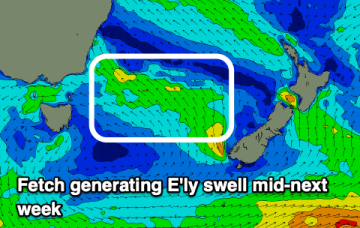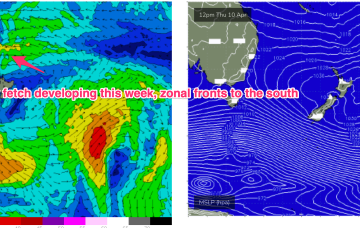After a binary interaction between the two systems, the merged low transitions into a storm force sub-tropical low which tracks SW into the Northern Tasman. This storm force low has a broad fetch aimed directly at the East Coast down to Tasmania, generating a large E’ly quadrant swell for Good Friday and the Easter weekend with uncommonly large swell periods for swells from that direction.
Primary tabs
Certainly by Wed into Thurs the synoptic chart should look insane with a deep low (970-980hPa) retrograding into the Tasman, positioned inside the North island with plenty of space for severe gale to low end storm force winds to be aimed up at the east coast.
The coming period is a bit hit and miss but the middle of next week should offer a wave.
We’ll see a long E’ly fetch develop through the South Pacific slot through the end of this week, enhanced by a trough of low pressure near New Caledonia which is attached to a still active monsoon trough. Swells from this source may eventually reach NETas later next week.
A front passes into the Tasman overnight and robust fetch of SW gales is trailing behind, currently sweeping NE past the SE coast of Tasmania. We’ll see a moderate S swell generated by this fetch, with a dominant high moving into the Tasman in it’s wake and strengthening through the week
Make the most of the east swell ahead of a trickier, smaller run of south swell.
As of this morning our deep Tasman low (984hPa) is still slow moving although high pressure support has slipped in under the low with the strongest winds now aimed more at Tasmania.
As of this morning our deep Tasman low (984hPa) is still slow moving although high pressure support has slipped in under the low with the strongest winds now aimed more at Tasmania.
These winds will coalesce later today into a more organised fetch of S-SE gales as the system slowly tracks southwards then S/SE. As a result we’ll see elevated wave heights from the E/SE-S/SE right into mid-week, augmented by some long range S/SE groundswell from another ice shelf fetch in the Ross Sea region adjacent to Antarctica.
By Sun we’ll see a low forming off the South Coast with a strong SE infeed along the southern flank of the low. That will see strong S/SE winds through Sun and building swells from the same direction.










